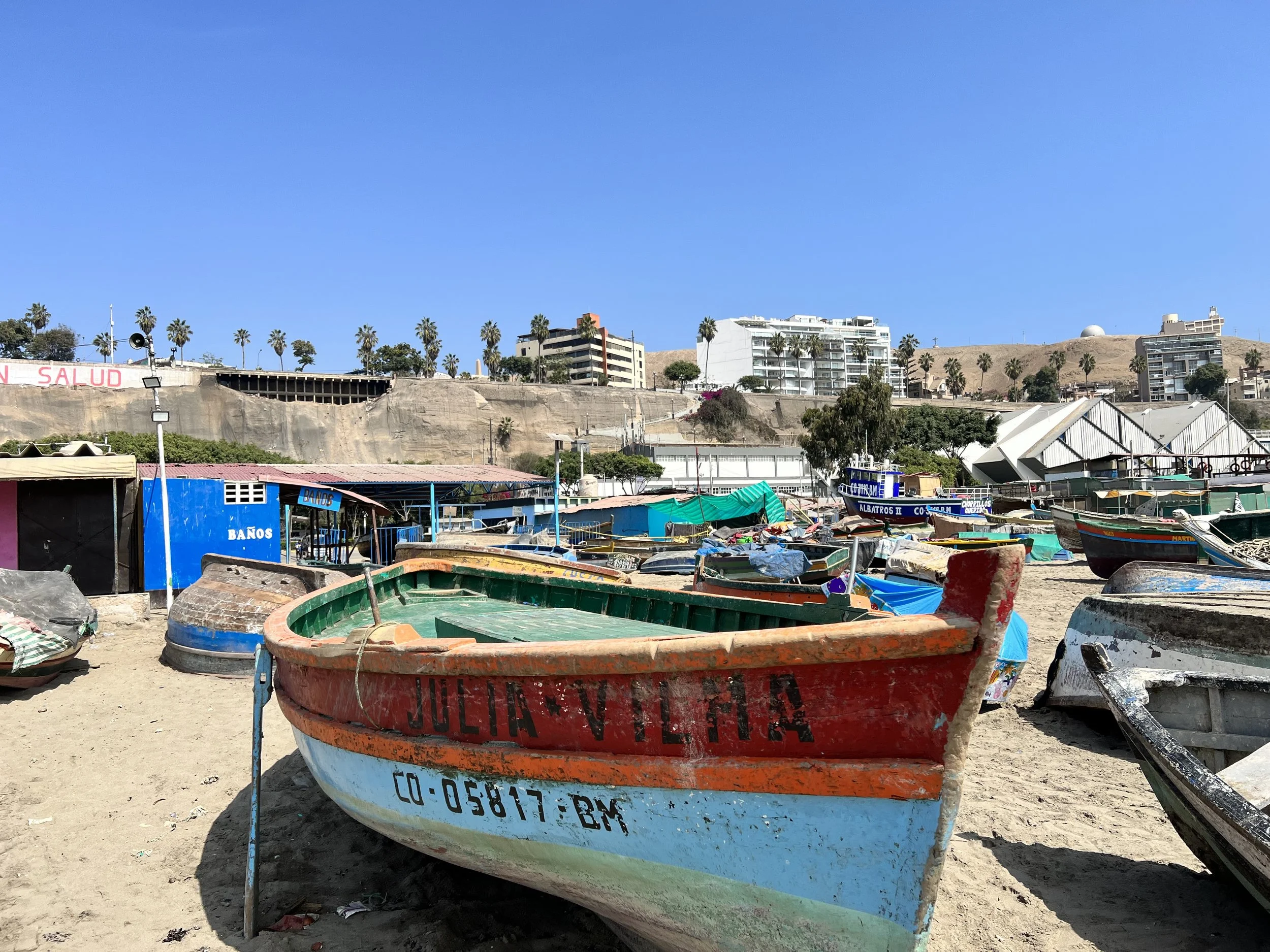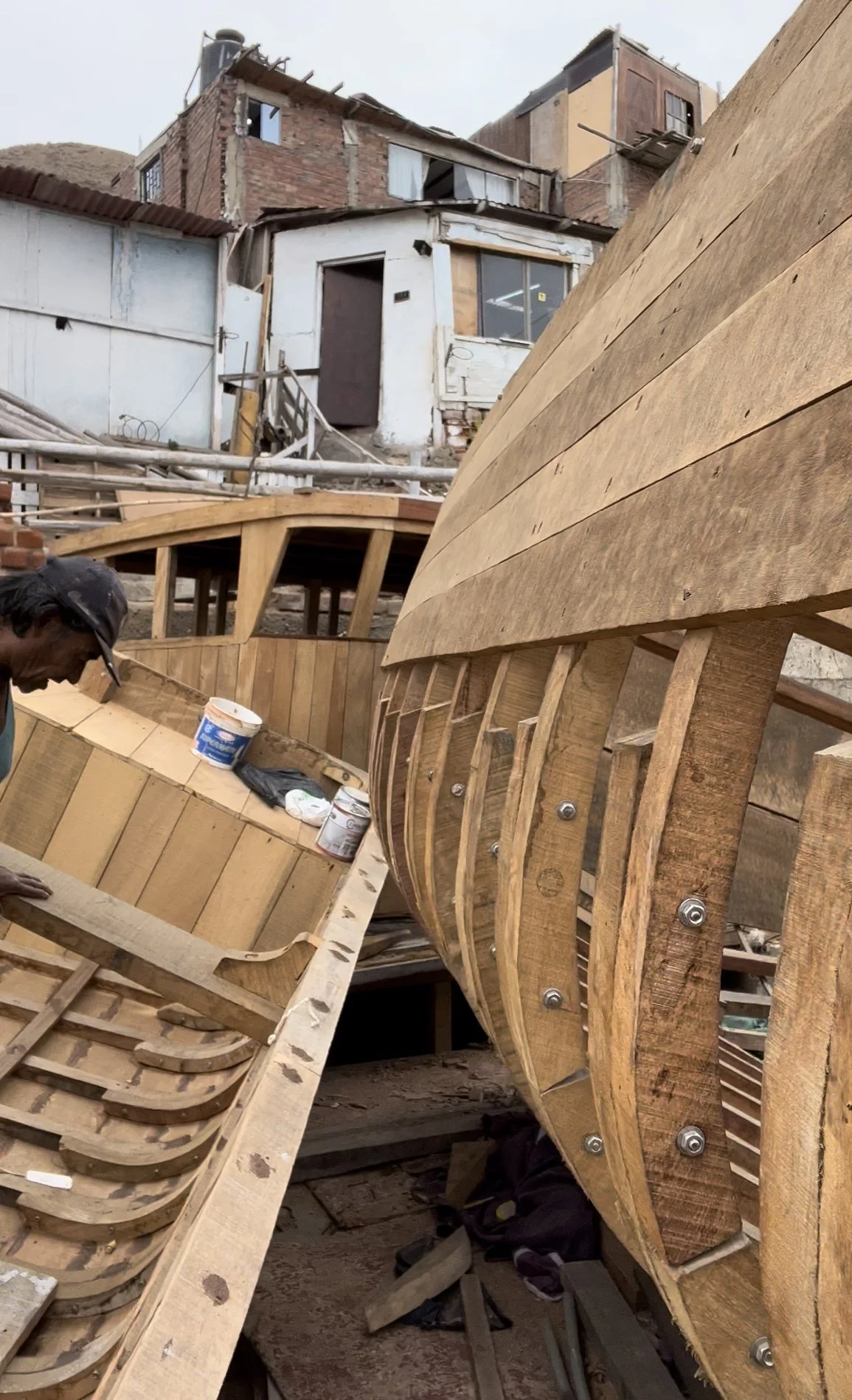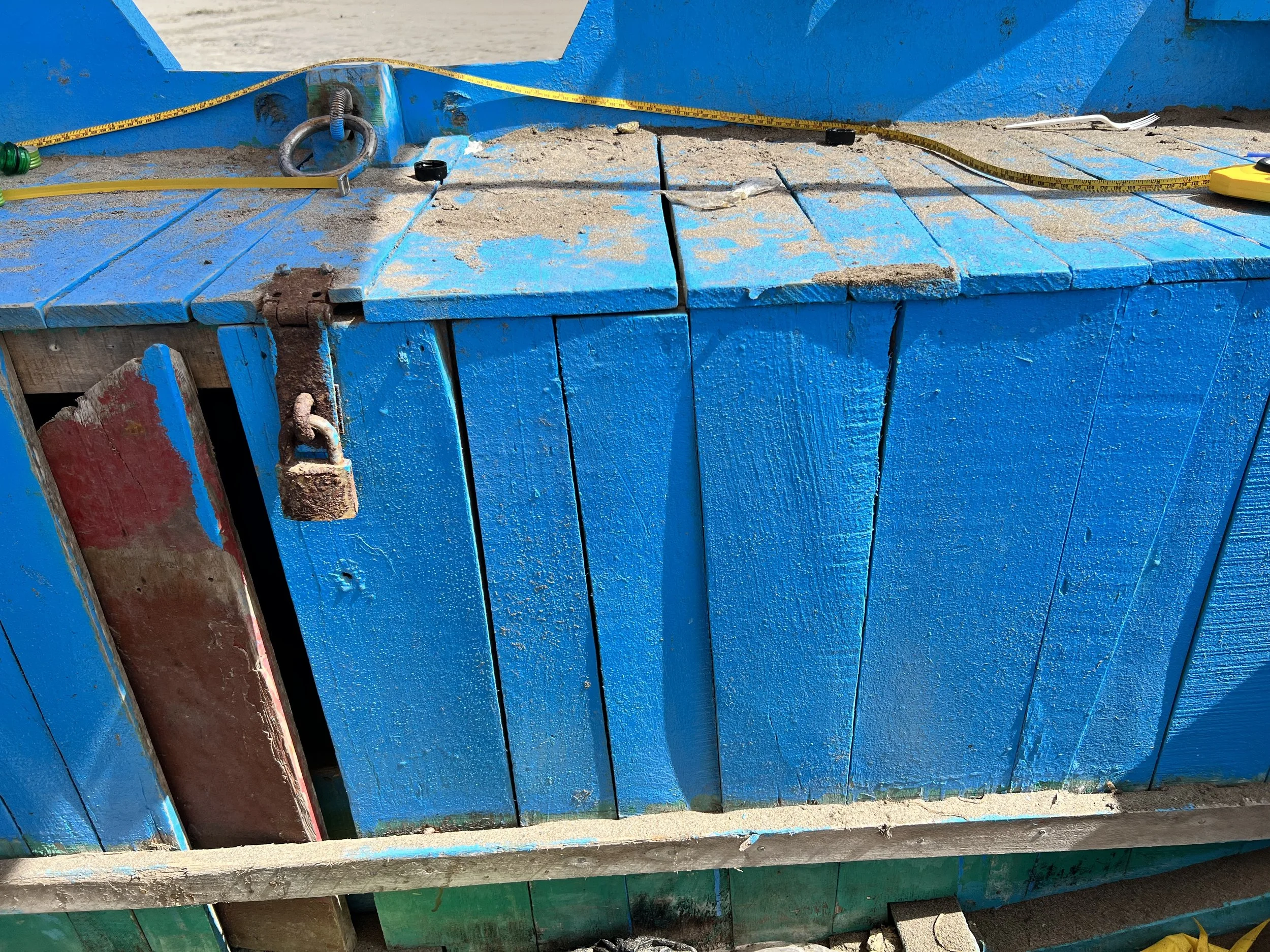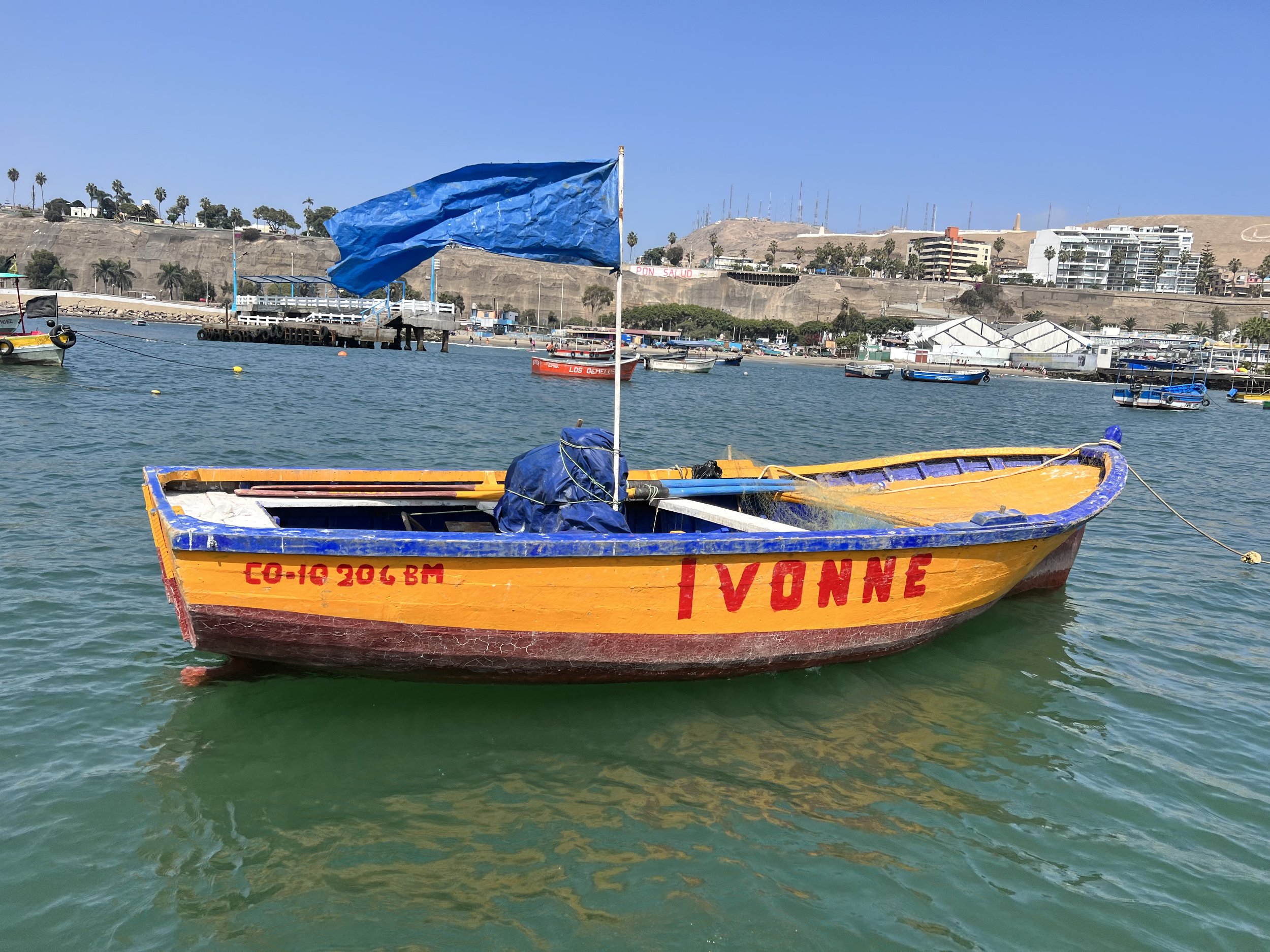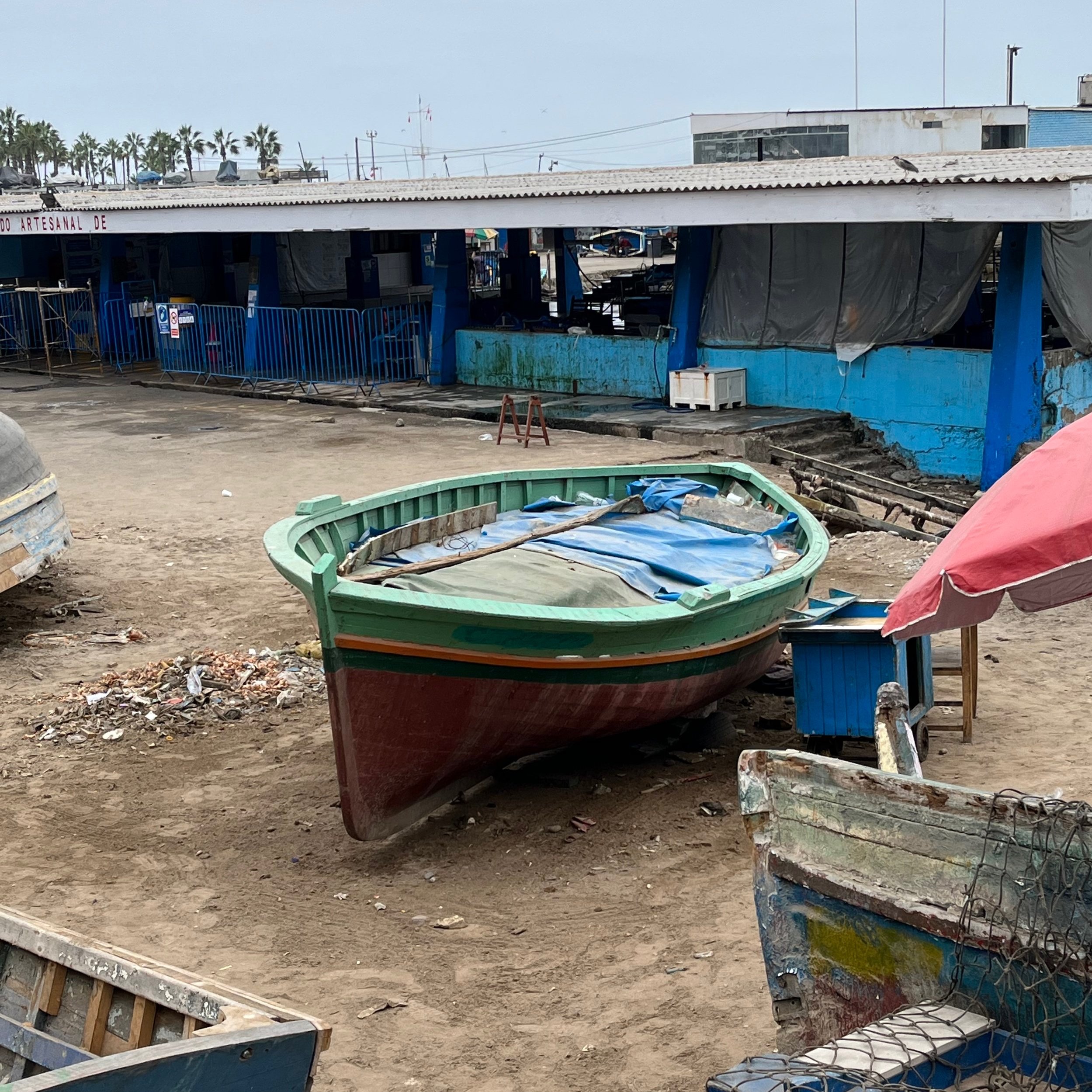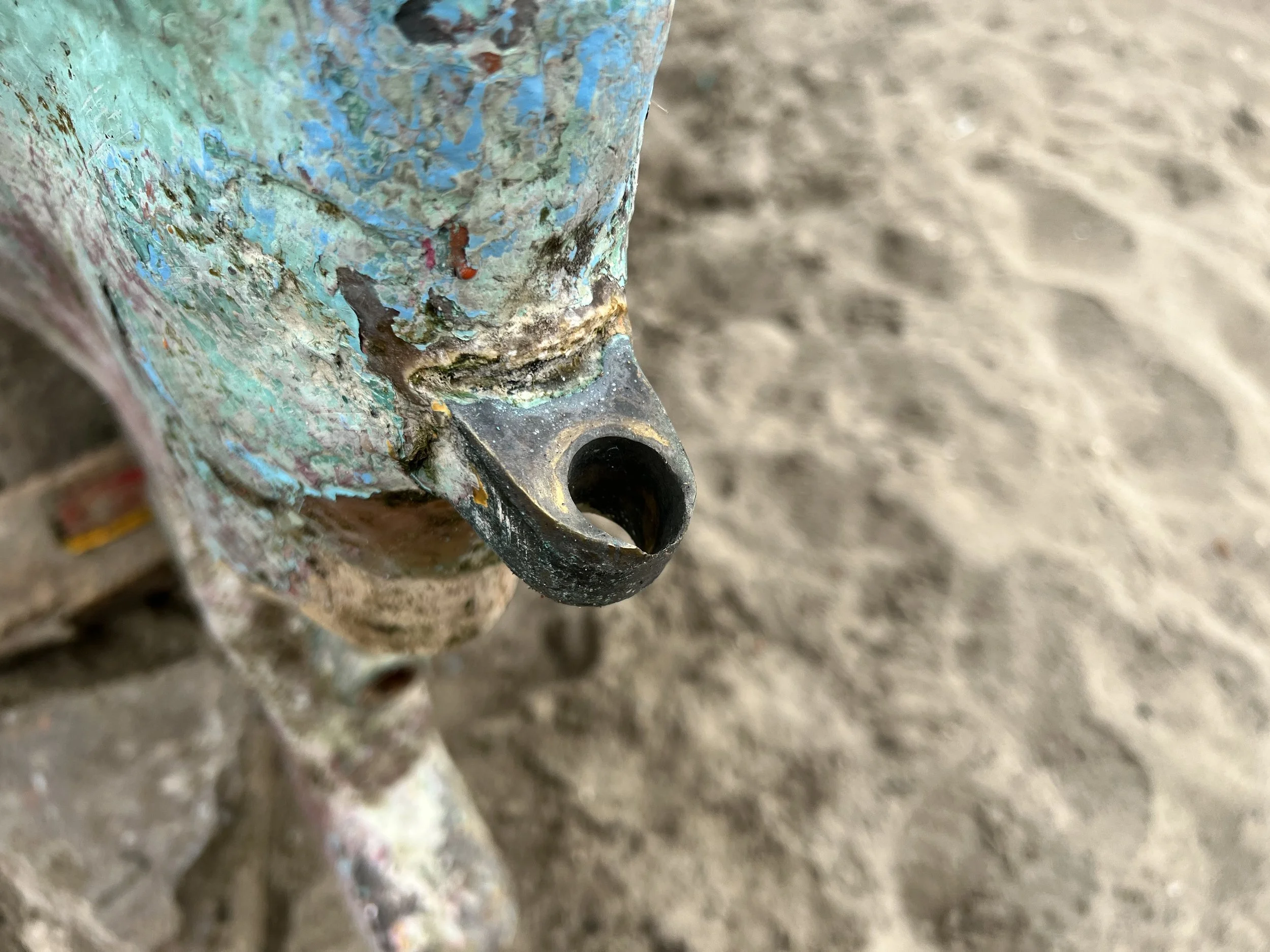Peruvian Traditional Boats Part 3
In part two we looked the the smaller boats of the Peruvian fishing fleet, the husky punt and the prolific vee-bottom dinghy. Now we’ll cast a discerning eye over the two larger types on the beach, the beamy fish boat, and the double ender.
The beamy fishing boat is the largest of the small boats, big enough to hold a serious catch, or plenty of tourists, and small enough to be hauled up the beach for maintenance. These boats are characterised by their broad transoms, relatively flat bottoms down aft, fine bows and generous flare; they have a decidedly Mediterranean look about them. They are powered either by inboard or outboard.
These boats, just like the rest of the fleet, are carvel planked over closely spaced frames, in most cases sawn frames are used, however I did see some with a combination of bent and sawn frames. Sawn being used up forward to gain the required flare. At the boatbuilder’s yard there were two of these beamy boats under construction, as well as a third, larger model, soon to be fitted with a wheelhouse. All three were built with sawn frames throughout. Each side of each frame on these vessels consists of three futtocks, cut from straight grained timber. The first futtock runs from the sheer down to the turn of the bilge, which is relatively sharp. This frame piece then butts into the next futtock which runs down to the keel. These two pieces are sistered by a third futtock that runs the length of the bilge radius. The interior of these boats usually consists of a sunken foredeck come storage compartment up forward, a few thwarts measuring 2” by 10”, and an aft seat come storage compartment. Keep in mind, these thwarts are installed straight from the mill, there’s no planning or sanding here, paint going straight over the rough surface left by the bandsaw mill; a few years of working will soon smooth it out. We wouldn’t want to waste time and money sanding unnecessarily, now would we?
The storage compartments are nice to look at, being constructed in a perfectly practical manner. I’m still yet to see any plywood on these boats, so solid timber is used to clad these large, flat surfaces. Where I’m from we’d use tongue and groove boards, all of equal width. Here they use miss-match planks, some wide, most narrow, some tapered, some parallel, these I can only assume are offcuts from the planking process, a perfectly good use of left-over timber that would otherwise be scrap, burnt under the steam box.
I measured one of these boats on the beach, it was a tourist boat, powered with an outboard motor. She was in fine condition. The boat in question measured 23’ 4” long, with a beam of 9’ 1”, her transom was 7’ 9” wide. The fellow that held the other end of the tape measure on this boat was a boatbuilder, or ‘carpintero de barcos’ as they say, so the measurements for the beam are taken from the outside of the planking, as opposed to the outside of the gunwales. This particular model had mostly bent frames, they measured roughly 1 3/8” sided by 1 3/4” moulded. Her planking was 5/8” thick, her keel was 3 1/4” by 7”. All the Peruvian fishing craft I measured had straight (profile) keels. In Western traditions this feature might seem somewhat unsophisticated, indeed on my own boat, Maiwar, I put a couple of inches of rocker in the keel. Was this necessary? Probably not; but it seemed like the right thing to do. I very much appreciate the no-nonsense approach to boat design and construction these men employ, efficiency reigns supreme here.
As we saw in the boat builder’s yard, these boats also have a chined version, a close cousin, similar in size, form and function. I saw a few of these amongst the moored boats, but for the most part, the round bilge boats are more common. I’ve come to really appreciate the beamy fish boat. Seeing these boats would, I believe, make the heart of any Mediterranean fisherman sing. Their legacy seems as bright as their future here on the beach at Chorrillos.
The Double-Ender
We’ll now move onto the last of the four types, the double ender. For me, she’s the sweetest of the boats on the beach, her fine lines are timeless and universal.
Pictured above is a fine model, however, not all the double enders are like this, they vary greatly in dimensions and hull shape. Some carry their beam further forward and aft from midships, holding a full bow and stern, some also have very full underwater stern sections. The full boats look very Mediterranean, the fine boats look much more whaleboat. Both styles are characterised by their rounded midship sections, shallow draught and fore ‘n’ aft symmetry . They have low freeboard and high bulwarks (always a striking combination) with a beautiful flush deck. This deck is broken up by two openings, the first is tucked right down aft, and is just large enough for the helmsman’s legs. He stands on a small platform atop the bilge stringers, from this position, with tiller in hand, he pilots his vessel, cutting quite the scene, as you can imagine. The other hatch is wide and long, it takes up perhaps half of the avaliable deck space, under here you will find a small petrol inboard motor connected to a 1” shaft and a three bladed bronze propellor. Forward of the motor, under the hatches, there is a thwart where these boats can be rowed from, as well as plenty of storage for nets, fish, a little stove and more. Although these boats all have inboard motors, they are also fitted with thole pins and a pair of oars, most of the thole pins I saw were rusty pieces of steel tube, others were timber. I imagine the oars are used when paying out the nets, as well as manoeuvring around the anchorage.
The decks are straight laid, caulked and payed. From what I observed, both hull and deck seams are caulked with very thin, 3 strand rope, laid directly into the seams and hammered home with a crude caulking iron and claw hammer. Of the boats I saw being build or rebuilt, all seams were payed with thickened epoxy, a perfectly suitable seam compound for these boats, I wonder how long this has been happening for?
For this piece I decided to measure the finest double ender I saw on the beach (pictured at the top of this section), she really captured my imagination. She was 22’ 3” long, with a beam of 8’ 1”. It was hard to judge her freeboard exactly (owing to the informal and often exaggerated antifoul line), but it was roughly 12”, her bulwarks were 11 3/4” high. Planking was, of course, 5/8” thick, sandwiched at the sheer by a heavy gunwale and inwale.
The rudders on these boats are a simple affair, hinging on two bronze gudegons. On all the double enders I saw, the top gudgeon was in fine condition, while the lower was very heavily worn. This is due to the lack of support where the heel of the rudder comes close to the end of the keel. This leaves a large unsupported area which is constantly under pressure from prop wash. So, naturally, the bottom gudegon wears at a great rate. Aside from these gudegons, there seems to be a complete lack of metal hardware on these boats, a cost saving feature for sure.
I happened to be on the beach when a sweet double ender had just come ashore. She was being readied to be hauled up the beach for her maintenance period. There were approximately 25 men, as well as a few excitable boys (I put myself in this category) gathered on the beach, waiting to give a hand. We began pushing and pulling with great exertion to get this boat 30 meters up the shore. It was much harder than I imagined, these are heavy boats. Four inch diameter posts were laid at right angles under the keel to aid this process. Everyone was in high spirits from the joy that comes from teamwork, we were shouting and grunting and laughing and smiling.
Once she was far enough up the beach, nestled amongst the fleet, the rudder was put under the gunwale on the port side, and an oar was stood vertically on the other, lashed to the thole pin, keeping the boat upright. Here she will sit for a time while the owner scrapes and paints her bottom, maybe some work on her engine and perhaps replace a plank here or there. No doubt she will be back out on the water as quick as she can, earning her keep on the coastal waters of Peru. These boats are as picturesque as one could hope to find on any beach around the world. Where I live these boats haven’t been working common for close to 100 years. But not Peru, here they still proudly motor out each day to make their living. What a joy it is to experience such a beautiful working craft.
